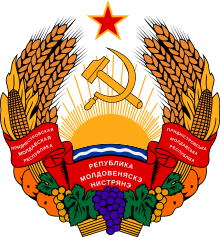2001 Transnistrian presidential election
Presidential elections were held in the breakaway republic of Transnistria on 9 December 2001.[1] The result was a victory for incumbent President Igor Smirnov, who received 82% of the vote.[1] The other candidates were Tom Zenovich, mayor of Bender (the second largest city in the country), and Alexander Radchenko of the Power to the People party, which advocated reunion with Moldova.
| |||||||||||||||||
| |||||||||||||||||
| |||||||||||||||||
 |
|---|
| This article is part of a series on the politics and government of Transnistria |
|
| See also |
Results
| Candidate | Party | Votes | % |
|---|---|---|---|
| Igor Smirnov | 208,617 | 81.85 | |
| Tom Zenovich | Independent | 17,018 | 6.68 |
| Alexander Radchenko | Power to the People | 11,853 | 4.65 |
| None of the above | 17,375 | 6.82 | |
| Invalid/blank votes | – | ||
| Total | 254,863 | 100 | |
| Registered voters/turnout | 405,248 | 62.89 | |
| Source: Olivia Press | |||
gollark: "1 + 1 is 2"
gollark: ++search oops
gollark: ++seach are you sure?
gollark: ++search no it won't
gollark: I actually just bodged it into kind of working by limiting results to 5.
References
- Eastern Europe, Russia and Central Asia 2003, Taylor & Francis, p265
This article is issued from Wikipedia. The text is licensed under Creative Commons - Attribution - Sharealike. Additional terms may apply for the media files.
.jpg)